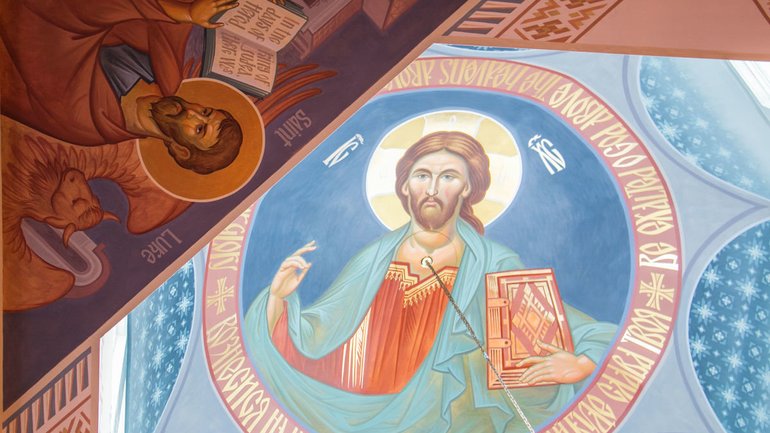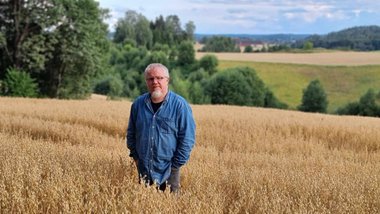Cathedral ‘built on perogies’ embraces its heritage


Three Ukrainian iconographers have written elaborate new icons on the dome and ceiling of Holy Eucharist Cathedral. The works, officially unveiled July 14, reveal the community’s emphasis on a return to its roots. (Photos by Agnieszka Krawczynski / The B.C. Catholic)
A small Byzantine community in New Westminster is embracing its culture after decades of masking itself as just another Roman Catholic church.
“Our Byzantine rite was not appreciated as much, so we were trying to look more like Roman Catholics – ‘Let’s just have two little icons, maybe one big icon, and that would be it. A crucifix, and we’ll be like our Roman Catholic brothers’ – without treasuring what we are meant to be and what we can be, if only we try,” said Father Mikhailo Ozorovych.
“Now, there is a great revival of Eastern Christianity and Byzantine rite, so we try to be as authentic as possible. We are Catholics, but we have our art, our theology, and our beauty to show to the world.”
That’s why Holy Eucharist Cathedral embarked on a project to write five major icons, laden with gold and rich in symbolism, inside its large dome.
Reclaiming a culture
Father Ozorovych flew Ukrainian iconographers Serhii Kolodka, Dmytro Vasylkiv, and Oleksii Cherednichenko to B.C. to write the masterpieces from June 5 to 23.
All masters of their craft, these artists have founded iconography guilds and written icons for many Ukrainian churches. Cherednichenko, an artist since the age of 10, has decorated 20 churches and his largest project covered 2,500 square metres, including a 27-metre-high dome.
Architecture and iconography are essential to Byzantine worship, said Father Ozorovych. Typically, icons cover the walls from top to bottom in Catholic churches in Ukraine. If there is anything on the ceiling, it’s an icon of Jesus Christ the Pantocrator (Ruler of All).
 Jesus Christ the Pantocrator.
Jesus Christ the Pantocrator.
Holy Eucharist Cathedral is far from coating its walls with icons, but it took a big step with this master project: Christ the Pantocrator, surrounded by the four evangelists.
Kolodka, Vasylkiv, and Cherednichenko spent 18 days at the cathedral, at times painting upside-down like Michelangelo, until they covered its dome and ceiling with brilliant images and patterns. Like the rest of the cathedral, the dome is embellished with gold.
Vasylkiv, a specialist in iconography using egg tempura on wood, considered it a “great honour and privilege” to “contribute to the growth and development of our church in Canada.”
The artists took turns using real gold leaf, artificial gold leaf, and gold-coloured acrylic paint. It’s a departure from iconography tradition, but not done to keep costs down, said Father Ozorovych.
“Gold is that feel of heaven, of richness and beauty, of heavenly realms present in church,” but real gold only sparkles in the sunshine, said Father Ozorovych.
On dark and rainy days, gold appears dark and almost black, so the artists also used artificial gold (which requires less light to sparkle) and acrylic gold paint (which always stays the same colour). That way, no matter the weather, some part of the work will always reflect the divine.
 An artist adds patterns mimicking Ukrainian embroidery to the cathedral’s dome.
An artist adds patterns mimicking Ukrainian embroidery to the cathedral’s dome.
The artists incorporated English and Ukrainian letters in their work, reflecting the common languages of those who worship there.
Surrounding the large icon of Christ the Pantocrator are small patterns, painted in red or shades of blue, that mimic Ukrainian embroidery, adding “a little bit of ethnicity.”
Built on perogies
Father Ozorovych launched the project after longtime parishioner Wally Komaryk (famous for his culinary pursuits, especially in support of the community’s perogy suppers and bake sales), died of cancer last year and left behind a significant donation to the church.
“The parish council and I talked about it, and though we need money, we decided we would not put it in the running costs of the parish,” the priest said.
In honour of Komaryk, and in preparation for the cathedral’s 50th anniversary in 2019, they decided to use the funds to embark on the church’s biggest art project yet.
Father Ozorovych said the entire process has been sprinkled with a series of fortunate events he believes shows the work is God’s will.
One “miracle” was acquiring scaffolding, he said. Father Ozorovych had contacted a local construction company and they came the next day to see the site and come up with a quote. Before workers scoped out the area, they spied a poster about a perogy sale and, to the priest’s surprise, said they’d lower the cost of scaffolding in exchange for perogies.
Father Ozorovych gratefully agreed, but was later dismayed when he received the discounted quote and found it was still three times over their budget.
He contacted the company again: “You’re already doing us a favour, but is there another way you could bring down the cost?” He found some able-bodied parishioners to provide some volunteer labour, and the company cut the quote in half, down to about $2,200.
“For this little parish, only 80 families, it is a lot of money, but it was provided by God in different ways,” he said.
“There is a saying that most Ukrainian churches in Canada were built on perogies.”
 The icon of Jesus Christ the Pantocrator between bars of scaffolding is seen during work on the dome.
The icon of Jesus Christ the Pantocrator between bars of scaffolding is seen during work on the dome.
Father Ozorovych listed other “miracles” that worked in their favour, such as obtaining visas for the master iconographers, and unseasonably cool June weather that made it bearable for them to work in the cathedral’s otherwise hot, window-filled dome.
Celebrating a community
Decorating a church, like strengthening a community, is a process, said Father Ozorovych.
“Building a church 50 years ago was a big endeavor for the small Ukrainian Catholic community,” and its lavish art has been installed slowly, over the years, by different artists.
“It’s very hard to build a perfect church from scratch.”
While scaffolding dominated the centre of the church this June, and hand-drawn sketches, paint brushes, and small buckets of paint could be found everywhere, Father Ozorovych did not drop his goal to invigorate his parishioners in their faith, tradition, and sense of belonging.
He held all regular Sunday services during the project. “Because we’ve stolen so much space for scaffolding, when people come, the church looks packed! It’s not usually like that on Sundays, but I like that feeling when all the pews are taken and people are squeezing in,” he said.
“That’s the hope: that this art, or liturgy and worship, will bring people closer to God, stronger in their faith, and deeper in their relationship with Christ, and we’ll have a full church all the time.”
And, in honour of their heritage, their hard work, and the parishioner whose donation made the art possible, a small detail was added to the final piece. In the icon of St. Luke, perched in a small window, lies one small perogy.












